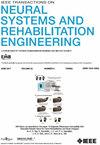基于多接受CNN的异步脑机接口通信和神经康复想象语音检测。
IF 5.2
2区 医学
Q2 ENGINEERING, BIOMEDICAL
IEEE Transactions on Neural Systems and Rehabilitation Engineering
Pub Date : 2025-07-24
DOI:10.1109/TNSRE.2025.3592312
引用次数: 0
摘要
想象中的基于语音的脑机接口(BCI)促进了脑信号驱动的直观交流,这是一种有效的语言康复工具,为语言和运动障碍患者提供实时、免提的互动。基于语音的助手系统依赖于唤醒词检测(例如,“嘿Siri”),而基于bci的通信系统必须从脑电图信号中捕获想象的开始,从而打开“大脑开关”,进一步传达用户想象的命令。然而,内源性范式缺乏可靠的基础真理增加了训练模型以从连续脑电图中捕获准确起始点的复杂性。为了解决这些问题,我们引入了一个多接受场卷积神经网络,旨在根据行为对齐的EEG特征捕获语音和空闲状态。我们提出了一种基于语音的真实对齐方法,该方法具有投票策略,旨在将想象语音与公开语音的开始和偏移同步,为异步BCI系统中的语音事件捕获提供了一种结构化方法。此外,谱和音系分析表明,β和α波段以及音节数似乎影响语音状态的可辨别性。对想象和公开言语任务的评估,包括伪在线实验,证明了增强异步脑机接口系统的潜力,支持健康和受损个体的实时通信。本文章由计算机程序翻译,如有差异,请以英文原文为准。
Imagined Speech Detection Using Multi-Receptive CNN for Asynchronous BCI Communication and Neurorehabilitation
Imagined speech-based brain-computer interface (BCI) facilitates brain signal-driven intuitive communication which holds great promise as an effective speech rehabilitation tool, enabling real-time, hands-free interaction for individuals with speech and motor impairments. While speech-based assistant systems rely on wake-word detection (e.g., “Hey Siri”), BCI-based communication system must capture imagined onset from EEG signals to turn on the ‘brain switch’ to further convey user’s imagined command. Nevertheless, the absence of reliable ground truth for the endogenous paradigm adds to the complexity to train the model to capture exact onset from continuous EEG. To address these issues, we introduce a multi-receptive field convolutional neural network, designed to capture speech and idle states based on behaviorally-aligned EEG features. We propose a voice-based ground truth alignment method with voting strategy that aims to synchronize imagined speech with overt speech onset and offset, providing a structured approach for capturing speech events in asynchronous BCI systems. Furthermore, spectral and phonological analyses revealed that beta and alpha bands, as well as syllable count, appear to influence speech state discriminability. Evaluations on imagined and overt speech tasks, including pseudo-online experiments, demonstrate the potential to enhance asynchronous BCI systems, supporting real-time communication for both healthy and impaired individuals.
求助全文
通过发布文献求助,成功后即可免费获取论文全文。
去求助
来源期刊
CiteScore
8.60
自引率
8.20%
发文量
479
审稿时长
6-12 weeks
期刊介绍:
Rehabilitative and neural aspects of biomedical engineering, including functional electrical stimulation, acoustic dynamics, human performance measurement and analysis, nerve stimulation, electromyography, motor control and stimulation; and hardware and software applications for rehabilitation engineering and assistive devices.

 求助内容:
求助内容: 应助结果提醒方式:
应助结果提醒方式:


